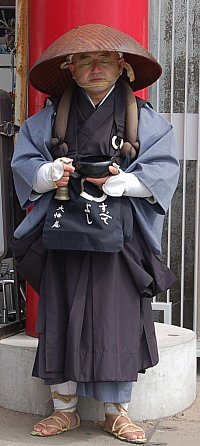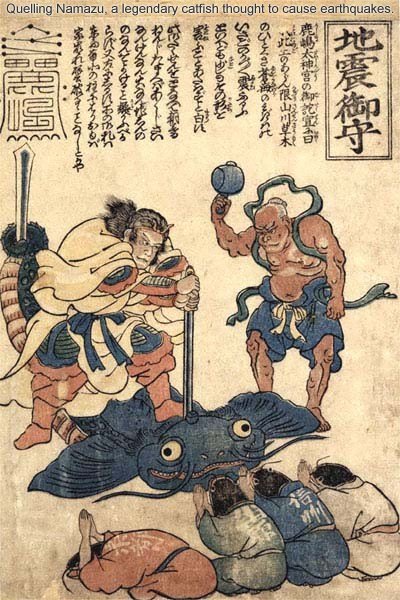|
|
|
|
 On Shaky Ground On Shaky Ground
Living with Uncertainty in Catastrophe-Stunned Japan
Story by Mark Schumacher, March 20, 2011
Written for hometown paper, Wabasso Standard, in rural Minnesota.
The killer earthquake rocked Japan on March 11 at 2:46 pm. At the time, I was sitting in my home-office in Kamakura city (some 280 miles southwest of the epicenter) working on mundane business matters. My wife Keiko was working at her office in Yokohama, some 10 miles north of Kamakura.
It began like any earthquake. “Oh, a minor tremor” I thought, and continued working. But it didn’t stop. The floor danced a jig, the wine glasses in the kitchen began to jingle, and I felt like a drunken fool. I ran out of the house in fear, but it didn’t stop. The bamboos around my house are drunk too, I mused, as they clattered loudly. Outside I found my next-door Japanese neighbor crouched nervously on the ground. She had fled to the wide-open spaces between our homes. “Wow, in 70 years, I’ve never experienced any earthquake as long as this,” she said. The ground continued to wobble. When it subsided some two minutes later, we returned to our homes, only to run outside again when aftershocks scared us silly.
We returned yet again to our homes, which were luckily undamaged. The real damage occurred about 200 miles northeast of Kamakura when giant 33-feet-high tsunami ocean waves smashed the coastline, devouring whole towns and killing thousands as they flooded some six miles inland. That region suffered the full fury of the magnitude 9.0 trembler and monster tsunami, but here in Kamakura (which suffered no physical damage whatsoever) the quake struck at magnitude 5.9 followed by eight-feet tsunami.
My heart was still pounding when the electricity suddenly failed. The sun was shining, so I prepared candles, flashlights, home heating (we use indoor kerosene heaters), and other essential matters. Just then, a hefty friend from England visiting Japan appeared at my door – he had been sightseeing in the area, and came straightaway to my house for safety. “I’m not trained like the Japanese. When the quake hit, they all dropped to the ground, but I stayed standing, swaying like a large oak.”
Worried about my wife, I told my English friend to join me on a 10-minute walk to the nearest convenience store, where we could stock up on food and call my wife using the store’s public pay phone (I don’t own a mobile). Off we journeyed, but when we arrived, there was a long line of Japanese people with the same idea. We waited, bought essentials, and luckily managed to contact my wife, who was safe and sound. Keiko returned home that same night, but she had to walk about 10 miles in darkness to get here (as the trains had stopped and electricity was off).
|

Buddhist monk begging
for donations to help
disaster victims.
(photo M. Schumacher)
|
|
Later that evening, with electricity restored, we watched the news in utter disbelief at the destruction. We contacted our families and friends – all safe!!!!! One of our friends living on the eighth floor of a Tokyo high-rise said the water from the toilet had swished back and forth so violently that it eventually spilled over. Another friend experienced the quake under his office desk while simultaneously witnessing the collapse of the next-door building.
The day after the “big one” hit Japan, millions of people in the Tokyo metropolitan area went to work as usual -- so did my wife -- despite disruptions to transportation, distribution, and electric power. They put up with long hours of delay getting to and from their offices. There was uncertainty and anxiety, but there was also a strong sense of unity. The government and Japanese people are in fact counting on this. “We’ve got to pull together, don’t panic, get to work rebuilding.” To me, this feeling of Japanese solidarity is palpable. It is a calming influence in troubled times.
Since then, we have experienced numerous aftershocks (minor tremors), worried constantly about conflicting reports concerning the damaged nuclear power plants in Fukushima (about 180 miles to the north), endured regular power blackouts, and dealt with long lines at the supermarket and gas station. Some friends told us of sleeping overnight in their cars as they waited hours and hours in long lines to get gas.
Yet the Japanese remain calm and orderly. There is no looting. Children here in Kamakura and Tokyo are still playing in the playground, kids are still going to school, and people are still traveling daily to work. Despite disruptions to the distribution network for basic goods, the shelves should be stocked again soon, as there is really no shortage of goods. There is panic buying, to be sure. Instead of purchasing just one carton of milk, people buy five. Basic items like milk, toilet paper, instant ramen, as well as flashlights and batteries, are thus hard to find. The supermarkets have responded by rationing. For example, only one milk carton per family, or only one pack of natto (protein-rich fermented soybeans) per family.
Some Japanese friends have temporarily left the Tokyo region, while Tokyo’s foreign community has left the city en masse, including embassy personnel, teachers at international schools, and employees of foreign businesses. They were frightened by exaggerated reports by Western media about pending doom from a nuclear meltdown. Indeed, the foreign press has done little to help the situation. Compared to the cautious reporting of Japanese media, foreign coverage is alarmist, sensationalist, and scare mongering. The foreign press talks of “apocalypse,” they write of British citizens “starving” in Tokyo, French residents swamped by a “toxic cloud of radiation,” and foreigners urged by their embassies to escape. This is bunk, perpetrated by Western media firms who excel at sensationalist hype. They have the luxury of passing on scary rumors because they have no stake in the matter. Shame on them.
Local Japanese coverage isn’t exactly perfect either. From a Western viewpoint, local Japanese coverage lacks any skepticism toward the official government line and is therefore suspect of evasion, of downplaying the gravity of the situation, and of hiding full details from the public. If only the Japanese press could be more forthright and the Western press less alarmist.
It is now over one week since the quake. Things are returning slowly to normal here in Kamakura as bottlenecks in distribution, power, and transportation are overcome. But the situation for hundreds of thousands of victims up north is still dreadful. We pray for the souls of the victims (both the living and dead) and for a speedy recovery. Whatever your religion, please pray to your God for mercy. Also please help by making a donation, no matter how small.
Donations Page
https://www.onmarkproductions.com/disaster-relief.html
About Mark & Keiko Schumacher
Mark hails from Wanda, Minnesota. He’s been living in Japan for over 20 years, and works as a free-lance translator, writer, editor, web designer, art historian, and exporter. His Japanese wife, Keiko, is a professional masseuse and beautician.
EARTHQUAKE TALISMAN
 |
ABOVE: Earthquake Talisman 地震御守. The deity Kashima Daimyōjin quelling Namazu, a giant catfish thought to cause earthquakes. Namazu 鯰 is a giant catfish thought to live deep inside the earth. Its movements are said to cause earthquakes. According to Japanese legend, Namazu’s movements can be controlled by Kashima Daimyōjin 鹿島大明神, commonly by placing a large rock called the pivot stone (kanameishi 要石) atop the creature or inside its mouth, or sometimes by stabbing it with a sword. Pictures (Namazu-e 鯰絵) depicting the catfish being killed or being personified appeared in large number after the Great Edo Earthquake of 1855. Most were unsigned. Above we see a 1855 woodblock print of Kashima Daimyōjin stabbing the catfish with his sword, assisted by a Buddhist deity with a mallet, while four fish-headed entities beg the catfish to stop its destructive thrashing. The names of various localities damaged in the 1855 earthquake (e.g., Shinshū 信州 near Nagano) are written on their robes.
Legends about Kashima Daimyōjin trace their origins to Kashima Jingū 鹿島神宮 (in Ibaraki Prefecture 茨城県). He is considered a manifestation of the shrine's central deity Takemikazuchi 建御雷神 (also written 建御雷之男神, 武甕槌神、武甕雷神), who is considered a protector against earthquakes. Another deity thought to quell earthquakes is Jinushigami 地主神 (lit. Landlord Deity or Land-Master Kami).
Staying Prepared in Earthquake-Prone Japan
- People who own cell phones can sign up for earthquake and tsunami alerts. When an alert is issued, subscribers will hear a special ring tone. Television broadcasts also provide alerts. In either case, the alerts come just seconds before the quake hits.
- Evacuation centers are well established in every neighborhood, with street signs pointing to the designated location. Detailed maps of escape routes are also distributed to each household.
- School children in Japan regularly practice emergency drills (just as American schools have fire and tornado drills).
- The government encourages all households to keep a Survival Kit near the doorway to their house. It should be stocked with water, energy foods, and matches to build a fire.
- All citizens are encouraged to keep a flashlight nearby. Many Japanese keep it next to their bed.
- Other good advice is to (a) grab your footwear before running out of the house to protect your feet against rubble, broken glass, etc.; (b) for clothes, grab long sleeves and long pants; find gloves if you have the chance; (c) walk to the evacuation center, don’t drive; if you are in your car during an emergency, park it, leave the keys inside, and don’t lock it; emergency personnel can then move your car in emergency situations.
- In case of radiation contamination, (a) keep all doors and windows shut; turn off fans and air conditioners to prevent contaminated air from entering; (b) if you must go outside, cover your mouth and nose with a wet towel or handkerchief; (c) if you went outside, wipe your shoes and clothes clean with a wet cloth or tissue; put them in a plastic bag and dispose; (d) don’t go outside if it is raining; (e) if available, take iodine pills to protect against thyroid disease; do not use disinfectants & gargles containing potassium iodine, as they are ineffective despite rumors on the Internet; this is because such products contain other ingredients harmful to the body and the amount of potassium iodine is too small to help.
RELATED PAGES
|
|